Biology > QUESTIONS & ANSWERS > Chapter 35—RESPIRATION. All Answers (All)
Chapter 35—RESPIRATION. All Answers
Document Content and Description Below
1. Cigarette smoking damages the respiratory system by: a. immobilizing ciliated cells b. killing white blood cells in respiratory tissue c. inhibiting mucus production d. killing whit... e blood cells and inhibiting mucus production e. immobilizing ciliated cells and killing white blood cells : e POINTS: 1 REFERENCES: Section 35.1 What is respiration? LEARNING OBJECTIVES: BIO.STAR.15.1 - Bloom's: knowledge KEYWORDS: Bloom's: Remember NOTES: New 2. The respiratory effects of marijuana smoke: a. are well-studied by scientists b. include exposure to carcinogens such as arsenic and ammonia c. include a large increase in carcinogenic lung tumors d. greatly decreases respiratory function e. raise the incidence of LDL (bad cholesterol) : b POINTS: 1 REFERENCES: Section 35.1 What is respiration? LEARNING OBJECTIVES: BIO.STAR.15.1 - Bloom's: knowledge KEYWORDS: Bloom's: Remember NOTES: New 3. Tobacco smoke: a. exposes the smoker to less than 10 carcinogens b. presents more of a risk to male smokers than to female smokers c. takes a long time to manifest in a decrease of respiratory function d. increases respiratory infections e. increases carbon dioxide blood levels but decreases carbon monoxide blood levels : d POINTS: 1 REFERENCES: Section 35.1 What is respiration? LEARNING OBJECTIVES: BIO.STAR.15.1 - Bloom's: knowledge KEYWORDS: Bloom's: Remember NOTES: New 4. In aerobic respiration, the reaction of glucose with oxygen yields: a. carbon dioxide only b. water only c. pyruvate d. carbon dioxide and water e. carbon dioxide, water, and pyruvate : d POINTS: 1 REFERENCES: Section 35.1 What is respiration? LEARNING OBJECTIVES: BIO.STAR.15.1 - Bloom's: knowledge KEYWORDS: Bloom's: Remember 5. The steepness of the concentration gradient across the respiratory membrane affects gas exchange, with a steeper gradient ____. a. decreasing the rate of gas exchange b. increasing the rate of gas exchange c. decreasing the levels of carbon dioxide in the blood only d. increasing the levels of hemoglobin-bound oxygen only e. increasing the number of red blood cells : b POINTS: 1 REFERENCES: Section 35.1 What is respiration? KEYWORDS: Bloom's: Remember NOTES: New 6. In insects, air enters through a ____ and is delivered to interstitial fluid. a. spicule b. spiracle c. stoma d. foramen e. gill : b POINTS: 1 REFERENCES: Section 35.2 What are invertebrate respiratory organs? LEARNING OBJECTIVES: BIO.STAR.15.1 - Bloom's: knowledge KEYWORDS: Bloom's: Remember 7. The movement of both oxygen and carbon dioxide in the body is accomplished by: a. exocytosis and endocytosis b. bulk flow c. osmosis d. diffusion e. facilitated diffusion : d POINTS: 1 REFERENCES: Section 35.2 What are invertebrate respiratory organs? LEARNING OBJECTIVES: BIO.STAR.15.1 - Bloom's: knowledge KEYWORDS: Bloom's: Remember 8. Adult insects exchange respiratory gases primarily by means of: a. spiracles only b. tracheal tubes and spiracles c. lungs d. gills e. body surface : b POINTS: 1 REFERENCES: Section 35.2 What are invertebrate respiratory organs? LEARNING OBJECTIVES: BIO.STAR.15.1 - Bloom's: knowledge KEYWORDS: Bloom's: Remember 9. Most aquatic invertebrates that have a circulatory system use internal or external ____. a. tracheal tubes b. spiracles c. lungs d. gills e. body walls for direct diffusion : d POINTS: 1 REFERENCES: Section 35.2 What are invertebrate respiratory organs? LEARNING OBJECTIVES: BIO.STAR.15.1 - Bloom's: knowledge KEYWORDS: Bloom's: Remember NOTES: New 10. External gills that are later replaced by paired lungs are found in: a. fish b. amphibian larvae c. frogs d. reptiles e. mammals : b POINTS: 1 REFERENCES: Section 35.3 What are vertebrate respiratory organs? LEARNING OBJECTIVES: BIO.STAR.15.1 - Bloom's: knowledge KEYWORDS: Bloom's: Remember 11. The group of animals with an efficient respiratory system, in that there is no “stale air” after exhalation, is the: a. amphibians b. birds c. mammals d. reptiles e. fish : b POINTS: 1 REFERENCES: Section 35.3 What are vertebrate respiratory organs? LEARNING OBJECTIVES: BIO.STAR.15.2 - Bloom's: comprehension KEYWORDS: Bloom's: Understand NOTES: Modified 12. In fish, countercurrent exchange involves water flowing over gills and blood flowing through gill capillaries in opposite directions. This increases gas exchange by creating a(n): a. larger surface area b. osmotic gradient c. concentration gradient d. reservoir for gas e. source of new hemoglobin : c POINTS: 1 REFERENCES: Section 35.3 What are vertebrate respiratory organs? KEYWORDS: Bloom's: Remember NOTES: New 13. In which group does most of the carbon dioxide formed during aerobic respiration leave across the skin? a. fish b. insects c. lizards d. amphibians e. snakes : d POINTS: 1 REFERENCES: Section 35.3 What are vertebrate respiratory organs? LEARNING OBJECTIVES: BIO.STAR.15.1 - Bloom's: knowledge KEYWORDS: Bloom's: Remember 14. Which group of animals relies on both lungs and integumentary gas exchange? a. amphibians b. birds c. mammals d. reptiles e. fish : a POINTS: 1 REFERENCES: Section 35.3 What are vertebrate respiratory organs? LEARNING OBJECTIVES: BIO.STAR.15.1 - Bloom's: knowledge KEYWORDS: Bloom's: Remember NOTES: Modified 15. The first lungs evolved from outpouchings of the gut wall in some: a. bony fishes b. amphibians c. birds d. reptiles e. early mammals : a POINTS: 1 REFERENCES: Section 35.3 What are vertebrate respiratory organs? LEARNING OBJECTIVES: BIO.STAR.15.1 - Bloom's: knowledge KEYWORDS: Bloom's: Remember 16. Gases enter and leave a mammal’s body by diffusing across a: a. membrane made up of multiple cell layers b. hard exoskeleton c. thin, moist membrane d. set of gills e. protective layer of thick cells : c POINTS: 1 REFERENCES: Section 35.4 What are the components of the human respiratory system? LEARNING OBJECTIVES: BIO.STAR.15.1 - Bloom's: knowledge KEYWORDS: Bloom's: Remember 17. Vocal cords are made of: a. smooth muscle b. cartilage c. skeletal muscle d. ligaments e. tendons : c POINTS: 1 REFERENCES: Section 35.4 What are the components of the human respiratory system? LEARNING OBJECTIVES: BIO.STAR.15.1 - Bloom's: knowledge KEYWORDS: Bloom's: Remember Selecting the Exception 18. Four of the five s listed below are components of the human respiratory system. Select the exception. a. thoracic cavity b. trachea c. diaphragm d. spiracle e. larynx : d POINTS: 1 REFERENCES: Section 35.4 What are the components of the human respiratory system? LEARNING OBJECTIVES: BIO.STAR.15.1 - Bloom's: knowledge KEYWORDS: Bloom's: Remember OTHER: Selecting the Exception 19. Four of the five s are correct statements about breathing. Select the exception. a. During inhalation, the chest cavity expands. b. Inhalation is powered in part by the diaphragm. c. Muscles in the walls of the lungs aid in enlarging the lung volume. d. During exhalation, the diaphragm moves upward. e. A respiratory cycle is one breath in (inhalation) and one breath out (exhalation). : c POINTS: 1 REFERENCES: Section 35.5 How do we breathe? LEARNING OBJECTIVES: BIO.STAR.15.1 - Bloom's: knowledge KEYWORDS: Bloom's: Remember 20. Gas exchange in mammalian lungs occurs in the a. villi b. anterior air sacs c. posterior air sacs d. bronchioles e. alveoli : e POINTS: 1 REFERENCES: Section 35.4 What are the components of the human respiratory system? LEARNING OBJECTIVES: BIO.STAR.15.1 - Bloom's: knowledge KEYWORDS: Bloom's: Remember NOTES: Modified 21. What is the proper sequence in the flow of air in mammals? a. nasal cavities, larynx, pharynx, bronchi, trachea b. nasal cavities, pharynx, bronchi, larynx, trachea c. nasal cavities, pharynx, larynx, trachea, bronchi d. nasal cavities, larynx, pharynx, trachea, bronchi e. nasal cavities, bronchi, larynx, trachea, pharynx : c POINTS: 1 REFERENCES: Section 35.4 What are the components of the human respiratory system? LEARNING OBJECTIVES: BIO.STAR.15.1 - Bloom's: knowledge KEYWORDS: Bloom's: Remember 22. Contraction and relaxation of smooth muscle in the wall(s) of ____ can alter its diameter and air flow. a. alveoli b. bronchioles c. bronchi d. trachea e. larynx : b POINTS: 1 REFERENCES: Section 35.4 What are the components of the human respiratory system? KEYWORDS: Bloom's: Remember NOTES: New 23. When humans breathe using only the mouth, which of the following is most diminished? a. filtering b. warming c. moisturizing d. texturizing e. vocalizing : a POINTS: 1 REFERENCES: Section 35.4 What are the components of the human respiratory system? LEARNING OBJECTIVES: BIO.STAR.15.2 - Bloom's: comprehension KEYWORDS: Bloom's: Understand 24. Food and drink are prevented from entering the respiratory passageways during swallowing by means of the: a. glottis b. pharynx c. epiglottis d. larynx e. trachea : c POINTS: 1 REFERENCES: Section 35.4 What are the components of the human respiratory system? LEARNING OBJECTIVES: BIO.STAR.15.1 - Bloom's: knowledge KEYWORDS: Bloom's: Remember 25. The human vocal cords are located in the: a. glottis b. pharynx c. trachea d. larynx e. bronchus : d POINTS: 1 REFERENCES: Section 35.4 What are the components of the human respiratory system? LEARNING OBJECTIVES: BIO.STAR.15.1 - Bloom's: knowledge KEYWORDS: Bloom's: Remember 26. Inhalation is always ____ while exhalation is usually ____. a. active; active b. active; passive c. passive; active d. passive; passive e. variable depending on oxygen content; fixed : b POINTS: 1 REFERENCES: Section 35.5 How do we breathe? LEARNING OBJECTIVES: BIO.STAR.15.1 - Bloom's: knowledge KEYWORDS: Bloom's: Remember 27. The pacemaker for inhalation is located in the: a. alveoli b. bronchi c. diaphragm d. hypothalamus e. medulla oblongata : e POINTS: 1 REFERENCES: Section 35.5 How do we breathe? LEARNING OBJECTIVES: BIO.STAR.15.1 - Bloom's: knowledge KEYWORDS: Bloom's: Remember 28. Choking involves blockage of the ____. a. larynx b. pharynx c. nasal passage d. bronchiole e. alveoli : a POINTS: 1 REFERENCES: Section 35.5 How do we breathe? KEYWORDS: Bloom's: Remember NOTES: New 29. During inhalation, the ____. a. external intercostal muscles relax b. pressure in the lungs is less than atmospheric pressure c. diaphragm moves upward and becomes more curved d. chest cavity volume decreases e. lung pressure increases : b POINTS: 1 REFERENCES: Section 35.5 How do we breathe? LEARNING OBJECTIVES: BIO.STAR.15.2 - Bloom's: comprehension KEYWORDS: Bloom's: Understand NOTES: Modified 30. The levels of ____ in the blood are usually responsible for altering breathing patterns. a. carbon dioxide b. oxygen c. nitrogen d. hydrogen e. hemoglobin : a POINTS: 1 REFERENCES: Section 35.5 How do we breathe? LEARNING OBJECTIVES: BIO.STAR.15.1 - Bloom's: knowledge KEYWORDS: Bloom's: Remember NOTES: Modified 31. When pressure in the lungs falls below atmospheric pressure, ____. a. oxygen leaves the blood b. oxygen enters the blood c. air exits the lungs d. air flows into the lungs e. lung volume decreases 32. The maximum volume of air that moves in and out of the lungs with forced inhalation and exhalation is the ____. a. vital capacity b. tidal volume c. forced inhalation volume d. forced exhalation volume e. residual volume 33. Gases diffuse down a ____ gradient. a. volume b. temperature c. osmotic d. partial pressure e. chemical 34. Inhaled air has a higher partial pressure of oxygen than blood in pulmonary capillaries. Therefore, oxygen ____. a. dissociates from hemoglobin b. diffuses out of the blood, into the air c. diffuses into the blood from the air d. moves out of the lungs during exhalation e. does not cross the respiratory membrane 35. The partial pressure of oxygen is higher in the capillary blood than the interstitial fluid surrounding cells. Therefore oxygen moves from ____ to ____. a. blood; air b. blood; interstitial fluid c. air; interstitial fluid d. interstitial fluid; blood e. interstitial fluid; air 36. Most of the carbon dioxide produced by the body is transported to the lungs as ____. a. a gaseous form b. blood plasma c. potassium carbonate ions d. bicarbonate ions e. carbonic acid 37. What is the enzyme responsible for converting free carbon dioxide in the blood into forms in which it can be transported in the blood? a. carbonic anhydrase b. carboxypeptidase c. carbonase d. decarboxylase e. dehydrogenase 38. The respiratory membrane consists of alveolar epithelium, capillary endothelium, and ____. a. a lubricating secretion b. a connective tissue layer c. a fused basement membrane d. gas e. a pleural membrane 39. Which gas or gases bind to hemoglobin more strongly than oxygen? a. carbon monoxide only b. carbon dioxide only c. nitrogen only d. both carbon dioxide and carbon monoxide e. both carbon dioxide and nitrogen 40. In the accompanying figure, the structure that "powers" inhalations is located at letter ____. 41. In the accompanying figure, the structure at "C" is the: a. esophagus b. gullet c. epiglottis d. pharynx e. trachea 42. In the accompanying figure, the structure at "B" is the ____, which ____. a. tongue; produces speech b. epiglottis; closes the trachea c. larynx; produces sound d. epiglottis; closes the esophagus e. pharynx; holds the trachea open 43. In the accompanying figure, the alveoli are at letter ____. 44. In the accompanying figure, gas exchange occurs at letter ____. 45. What are some characteristics of a respiratory surface that are important for gas exchange? 46. When does a respiratory protein bind oxygen? 47. What are some of the different respiratory systems seen in animals? 48. Why do members of long-established, high-altitude populations not experience the dizziness, disorientation, and breathlessness associated with altitude sickness? 49. What are some of the problems involved with smoking? 50. How does smoking put people at greater risks of colds and infections? 51. What poisonous gas is present in cigarette smoke that binds to hemoglobin? Why is it dangerous? Choose the one most appropriate for each. a. the primary "windpipe" between larynx and bronchi b. contains a pair of vocal cords c. move the ribs d. throat cavity behind the mouth e. two immediate branches off of the trachea f. flap-like structure that points upward and allows air to enter the trachea; closed during swallowing g. contraction during inhalation moves it downward h. microscopically small pockets lined with moist epithelium REFERENCES: Section 35.4 What are the components of the human respiratory system? LEARNING OBJECTIVES: BIO.STAR.15.1 - Bloom's: knowledge KEYWORDS: Bloom's: Remember 52. alveoli : h POINTS: 1 53. bronchi : e POINTS: 1 54. diaphragm : g POINTS: 1 55. epiglottis : f POINTS: 1 56. intercostal rib muscles : c POINTS: 1 57. larynx : b POINTS: 1 58. pharynx : d POINTS: 1 59. trachea : a POINTS: 1 the question(s) in reference to the five components of respiratory systems listed below. a. pharynx b. larynx c. trachea d. bronchiole e. alveolus REFERENCES: Section 35.4 What are the components of the human respiratory system? LEARNING OBJECTIVES: BIO.STAR.15.1 - Bloom's: knowledge KEYWORDS: Bloom's: Remember OTHER: Classification Questions 60. The voice box is located here. : b POINTS: 1 61. This part of the respiratory tree does not have cartilage-reinforced walls. : e POINTS: 1 62. Gas exchange between the air in the lungs and their blood supply occurs here. : e POINTS: 1 63. Air moves from the nasal cavity into this component. : a POINTS: 1 64. Spent air moves from the bronchial tubes back to this component. : c POINTS: 1 Match the following respiratory diseases and disorders with the best description. a. sleep apnea b. tuberculosis c. pneumonia d. bronchitis e. asthma f. emphysema REFERENCES: Section 35.7 What causes respiratory diseases and disorders? KEYWORDS: Bloom's: Remember | Bloom's: Remember NOTES: New 65. active bacterial infection, cough up bloody mucus, have chest pain, and find breathing difficult : b POINTS: 1 66. thin, elastic alveolar walls are destroyed : f POINTS: 1 67. lung inflammation, can be caused by bacteria, viruses, and fungi : c POINTS: 1 68. inhaled allergen or irritant triggers inflammation, which constricts airways : e POINTS: 1 69. breathing repeatedly stops and restarts spontaneously : a POINTS: 1 70. inflammation of bronchial epithelium with excess mucous production and coughing : d POINTS: 1 [Show More]
Last updated: 1 year ago
Preview 1 out of 17 pages

Reviews( 0 )
Document information
Connected school, study & course
About the document
Uploaded On
Nov 27, 2019
Number of pages
17
Written in
Additional information
This document has been written for:
Uploaded
Nov 27, 2019
Downloads
0
Views
57


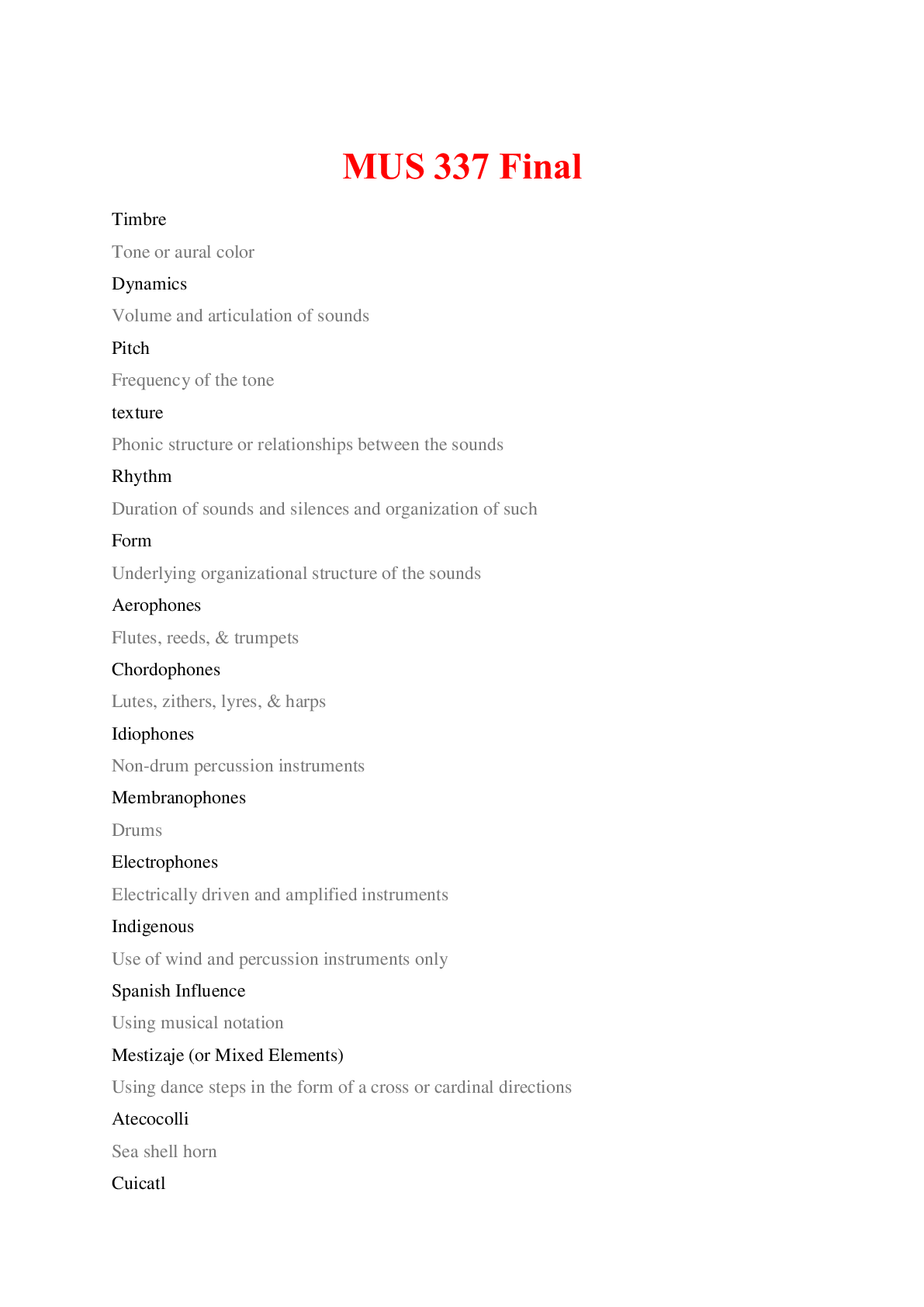







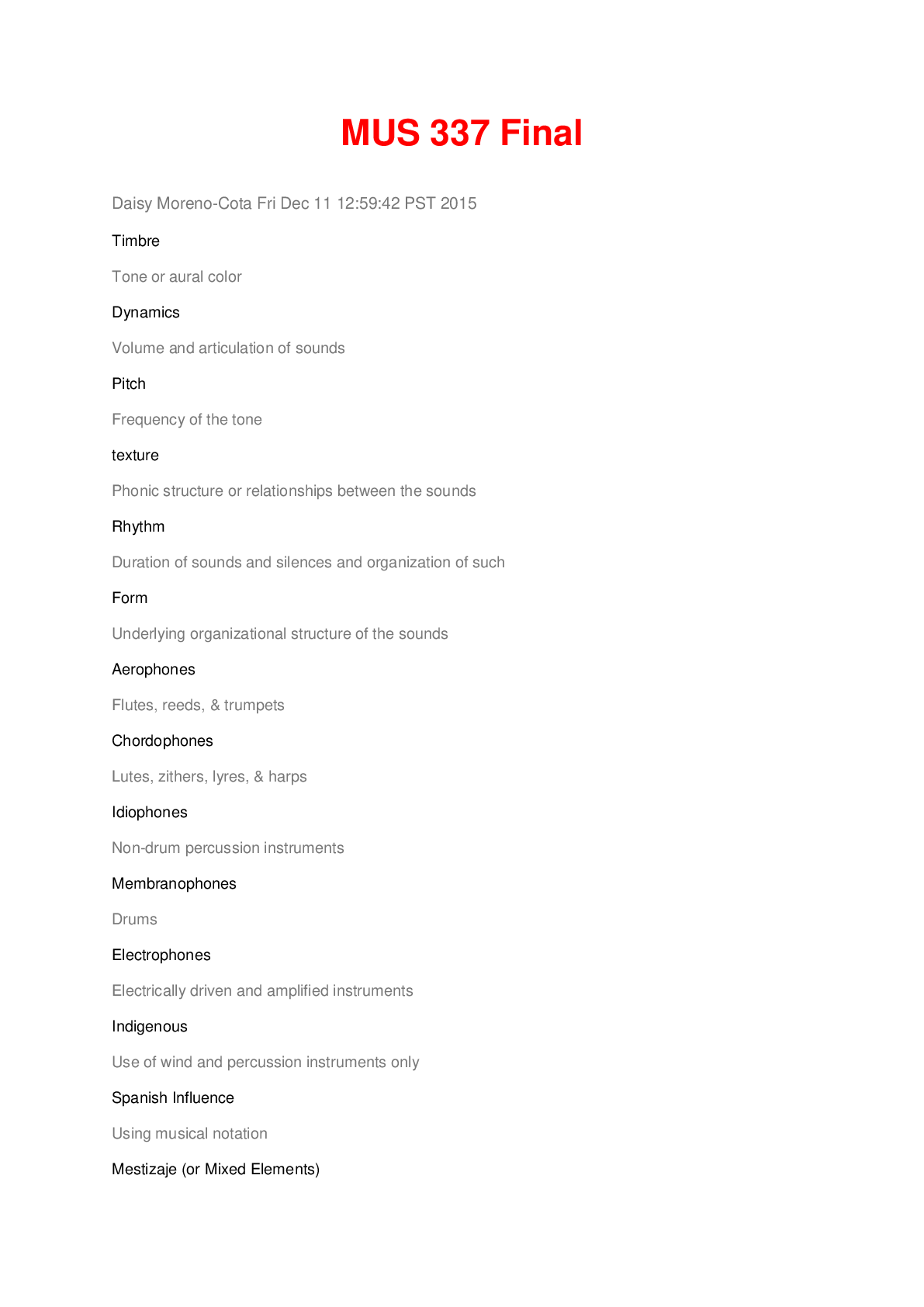




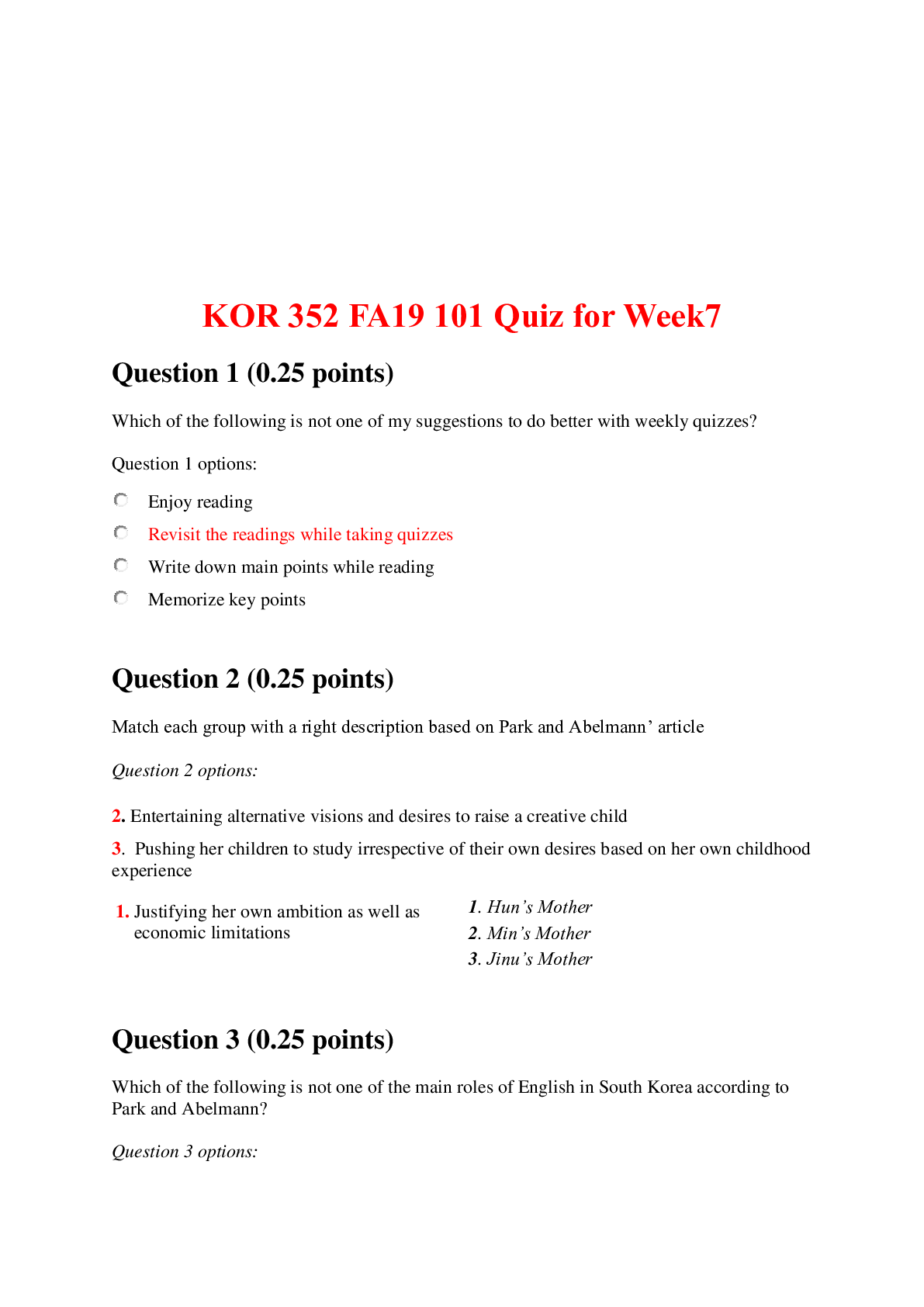



.png)

.png)

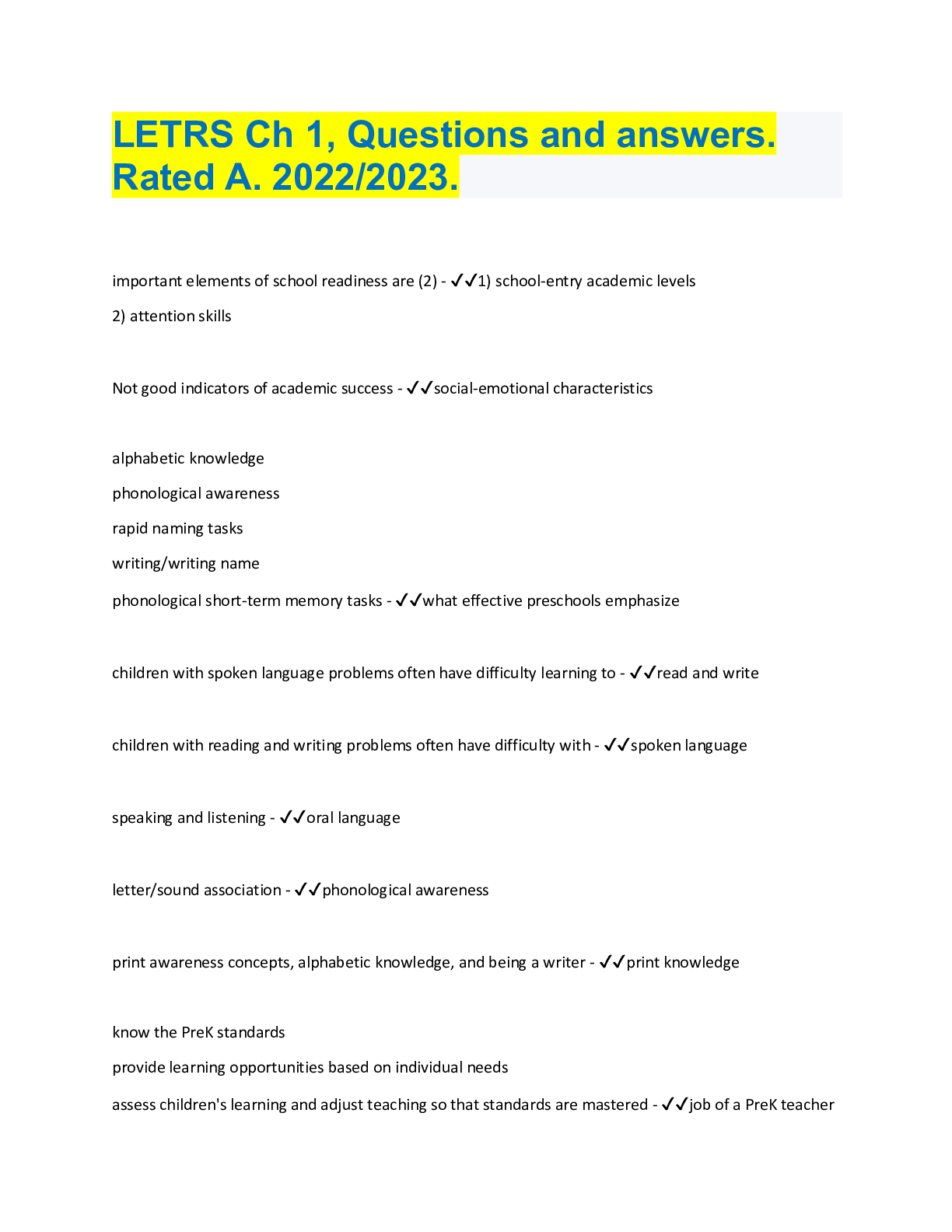
.png)
.png)

.png)
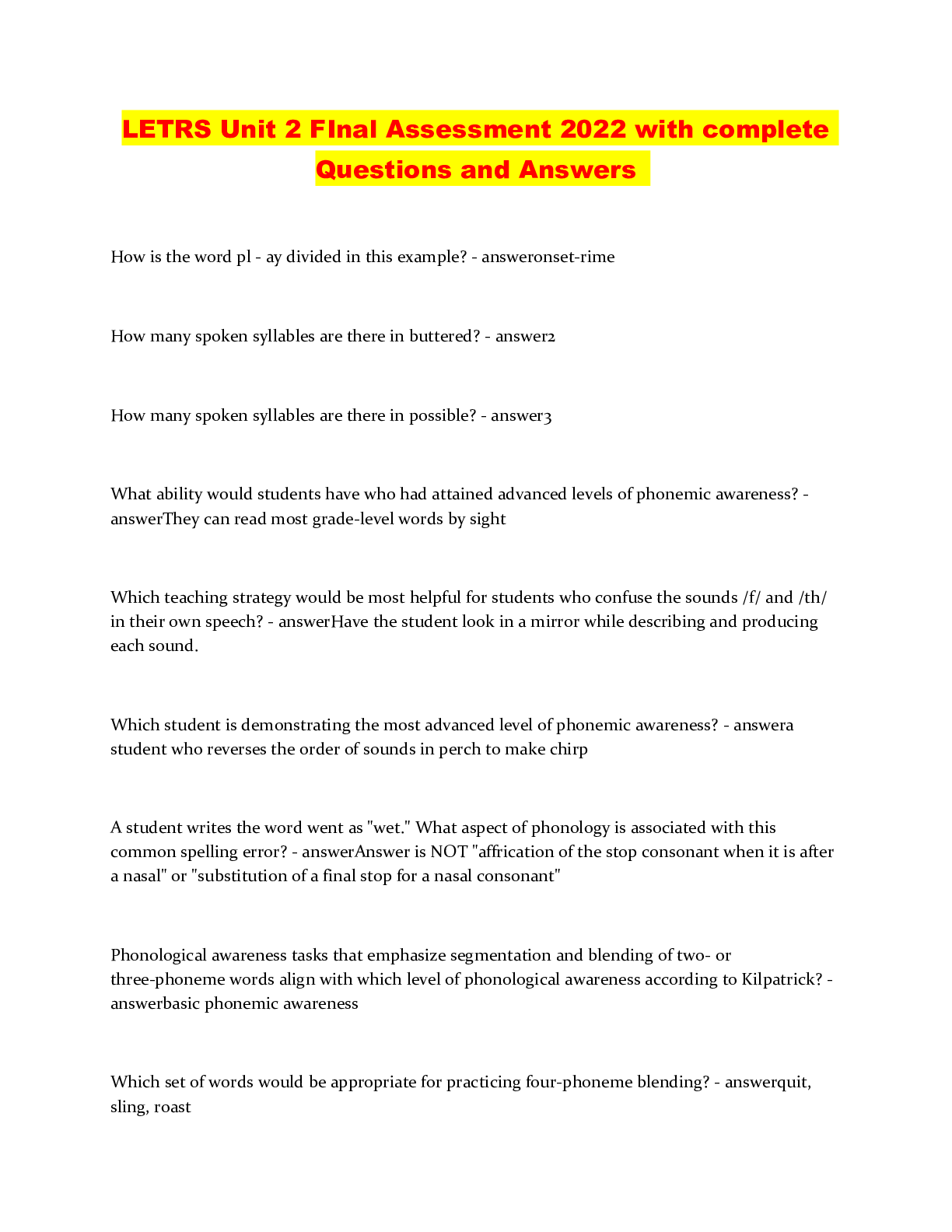



.png)
.png)

